This post is also available at surveyanon.
The title of this post might be quite a mouthful, so let's break it down a bit.
- "Affective gender identity" concerns how you feel about being a man vs being a woman. That is, in males, it's about how satisfied one is with being male, and how much one wants to be female. If for instance you are a trans woman, then your affective gender identity is almost certainly such that you are distressed about having male body parts and being seen as male, and that you want to live like a woman.
- However, "the ordinary range of variation" means that we aren't looking at trans women, who only make up a very small part of the population, but instead that we are looking at relatively ordinary men. Men have substantial variation in how they feel about being male, as has been discussed by rationalists before under labels such as "cis-by-default". For instance, in surveys of the rationalist community, around 50% of men feel like they wouldn't mind being women, and 50% of men feel like it would be distressing to be women.
- When I say I am doing a "comprehensive study of potential psychological causes" of this, what I mean is that I try to ask a large bunch of men an enormous number of questions about their values, personality, sexuality, experiences, and things like that, to try and untangle if any of these factors might be contributing to their affective gender identity. This is inherently a difficult problem, since surveys are kind of crude, and inferring causality at this level of analysis is not straightforward. I think the results here are worthwhile; but I'll let you be the judge of that.
This study is unfortunately probably not the definitive answer, if nothing else then because the key findings aren't replicated yet. I'll try to point out any limitations that I see, though. The following post describes my general analysis; if you would like to see the data to perform your own analysis, or to see the exact surveys used for the analysis, you can download them here.
Why?
One of the main things that we might want to do with a study of affective gender identity is to learn about trans people. However, at a first glance, this might make you conclude that my study is absurd! After all, by studying the ordinary range of variation, I'm excluding trans women, who are the individuals we would extrapolate onto.
I definitely think it would be worth doing further research into actual trans women to investigate the extent to which my results hold up. However, I don't think my methodology is as inherently absurd as you might think. For instance, one of my respondents in the survey wrote the following comment:
I have always felt deep down that I would prefer to be female. I prefer the way they dress and act and it always made me a bit jealous of girls. I feel I would be more comfortable in my own skin as a female. I have come to terms with the way that I feel and accept that I wouldn't want to go through a transition. I am okay with the way that feel now and have learned to accept those feelings.
I don't feel that I am traditionally very manly and feel more comfortable around girls
He is not trans, but anecdotally it seems to me that he is similar to how many trans women were before transition. Furthermore, it just seems like the very nature of affective gender identity would make it a major contributor to transitioning. Indeed, my impression is that the trans community would basically agree with this assessment of him (except maybe for the "he is not trans" part - rather than "close to trans", they might think he just is trans, and "repressing" it).
Contrast this to what some other men have said in the survey. For instance, combining comments from two men, another way that men within the normal range of variation can feel is:
It would be bad for me to be female. I think the phrase "fate worse than death" is fairly accurate. I think women are fine but I don't want to be one at all, even if I was both transformed into one and had my personality shifted. It just isn't me.
It is extremely important for me to be male. I enjoy being masculine I enjoy the banter men have, I enjoy having a male brain. I also extremely fancy women and think about sex a lot, I know I could be female and have those emotions but I think they are more intense as a man. I prefer the way men live their life’s with less drama, I don’t think having female friends as a female would suit me. I think men get more chances work wise in life than females. I also love being a dad and playing football with my son.
And then there's of course a lot of men distributed in the range between those two extremes, e.g. "I feel that I am male and a sudden change would be very difficult to process. … It's not something that you would be able to accept straight away." or "Having only known being male, I am curious about the experience of being female, and getting a sense of that perspective. Even if it were to remain permanent, I've lived long enough as a male to be satisfied with the experience." There seems to be a whole continuum there.
Presumably, there are some reasons that distinguish these different kinds of feelings from each other; some factors that make men lean more in one direction or another. And it seems likely to me that whatever those reasons are, they will also account for much of what leads trans women to transition rather than stay as cis men.
Now, it might be that you don't buy into this notion of a gender identity spectrum; that you don't think the first guy quoted has anything at all to do with trans women. If so, I would be interested in hearing why, because I don't think I've ever seen any strong arguments against that connection. But it would mean that this post would be of very limited value to you. For the rest of you, who think the notion makes sense, let's get on with the post!
Measuring affective gender identity
Speaking of affective gender identity, how do we measure it in the first place? If someone transitions genders to live like the opposite sex, we can probably make a reasonable inference that her affective gender identity strongly differs from the mean among cis men, but that only applies to the extremes, while I was studying the ordinary range. So how have I studied it? By asking people about it.
For instance, it may be instructive to look at one of the questions I used for measuring gender identity in the first couple of surveys in this study. There, I asked as follows:

Of course this question is not perfect. It's sort of arbitrary in which options it offers, and arguably some of these options implicitly make various assumptions about the question-answerer. I also followed it up with another question which supposed that one's psychology would change too, but it also has problems. For this reason, in one of the surveys, I included 60 other varied questions, such as:
- If one had the opportunity to magically become a woman, for how long of a period would one choose?
- Does one envy the appearance of women? Or their gender expression?
- Does one feel that one could be happy as a woman?
- Does one daydream about becoming a woman?
- Does one feel one fits the gender roles for men well?
- Would one feel disgusted when waking up as a woman? Or furious? Or humiliated? Or comfortable?
The questions are rather elaborate and repetitive, so I encourage you to look at the attached dataset for more detail. However, the overall finding I got is that men's responses to these questions were all correlated, and were highly "unidimensional" in the sense that there were not clusters of different questions that gave wildly different results from other clusters. One way to quantify the dimensionality is through the use of a "scree plot", where one looks at the amount of variation in question answers that exists in the first principal component, versus in the other principal components. If we do this for my dataset, then we get a scree plot like this:
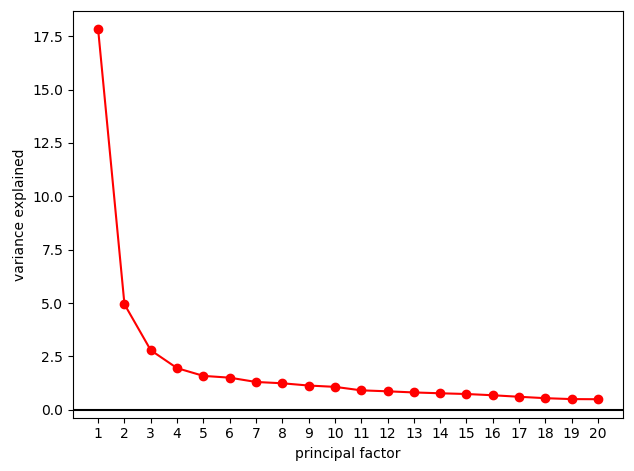
Now there does seem to be some very slight multidimensionality, but by far the most variation is consistently either more wanting to be a woman or not, so for the purposes of this study, I will not be doing much investigation into the different nuances of the feelings, but instead just consider overall affective gender identity.
The elephant in the room
We can't talk about the causes of gender identity without talking about autogynephilia.
Autogynephilia refers to a sexual interest in being a woman. The most well-known form of this is transvestic fetishism, where a man finds it erotic to wear women's clothes, but it can take on many other forms. It may be helpful to consider some examples of autogynephilic fantasies from men who did the survey:
(Note that these shouldn't be considered the full extent of how autogynephilic men feel about gender. These were given in questions where I explicitly asked about the sexual parts. Autogynephiles can feel additional emotional attachment to being a woman; for instance, the "almost trans" guy who I gave as motivation in the beginning of the post was autogynephilic.)
- "General lesbian sex fantasies involving power-play (Business woman and flight attendant, nurse and patient etc)"
- "I am wearing women's sexy underwear and I make love completely to a shemale, performing oral on them and receiving full anal penetration from them"
- "Being a domme"
- "I'm a curvy woman with big breasts having sex with a man and I am looking down at my body in missionary with the man on top of me"
- Etc.
There's also a lot of different possibilities, and if one has other sexual interests, it often seems to mix with those, leading to new presentations that combine multiple sexual interests at once. On the internet I've also commonly seen the erotic genre called "transgender transformations", which depicts men turning into women. Autogynephiles seem to be particularly into that.
The factor that makes autogynephilia particularly striking is that it is highly correlated with wanting to be a woman. For instance in this survey, I found a correlation of around 0.56-0.66. This is about comparable to the combined effect I get from all the other factors people nominated. For instance, if I take the first few principal components for all the questions attempting to assess other causes of gender issues, and use regression to try and predict gender identity from them, I get this plot:
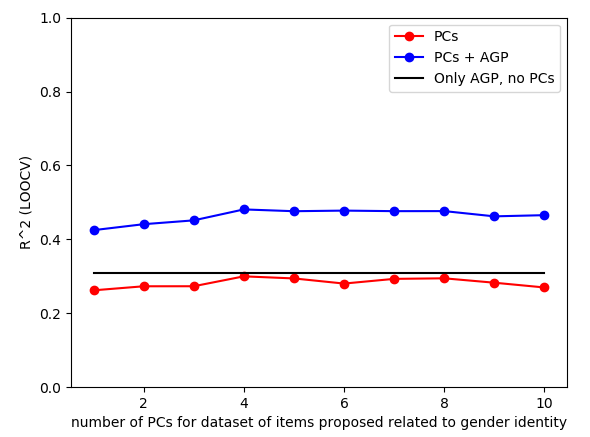
I think the correlation is there because autogynephilia causes males to want to be female, because this is how sexual interests generally work. For instance, heterosexual men want to have girlfriends and homosexual men want to have boyfriends, presumably because their sexuality makes them attracted to women and men respectively. I'd extrapolate this principle to autogynephilia. However, this is a controversial proposal; the trans community tends to argue that this claim is obviously wrong, and that autogynephilia is either an effect of affective gender identity (if you don't like being male and want to be female, of course this would also apply in the case of your sexuality, which is the context where being male/female has the clearest impact) or as an effect of brain feminization (so autogynephilia would be a form of female sexuality, which would then be correlated with males wanting to be a woman because there are males with feminized brains who as a result also want to be women).
For the record, here is a scatterplot of the correlation between autogynephilia and gender identity:
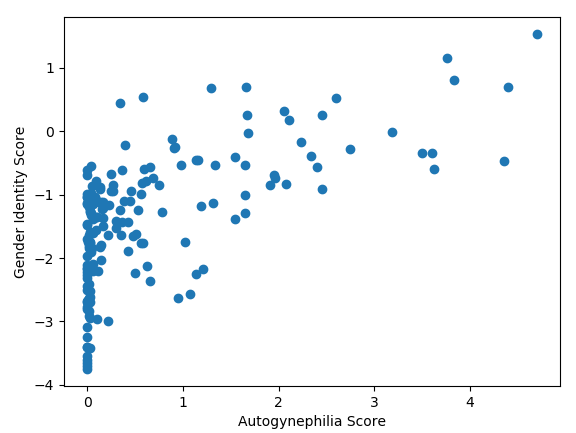
Meanwhile, the strongest well-defined competitor to autogynephilia that I found was gender conservativism, which looked as follows:
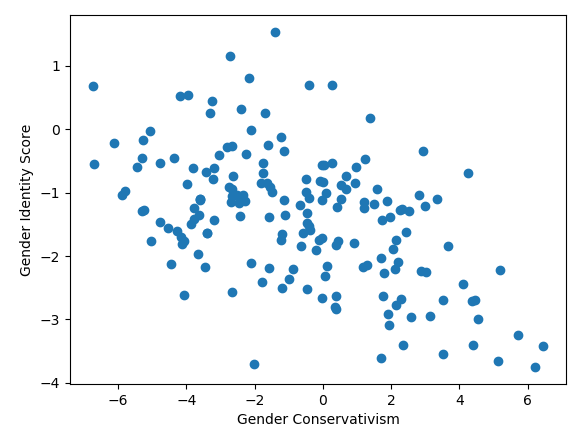
I can also plot both at once, using color to indicate gender identity:
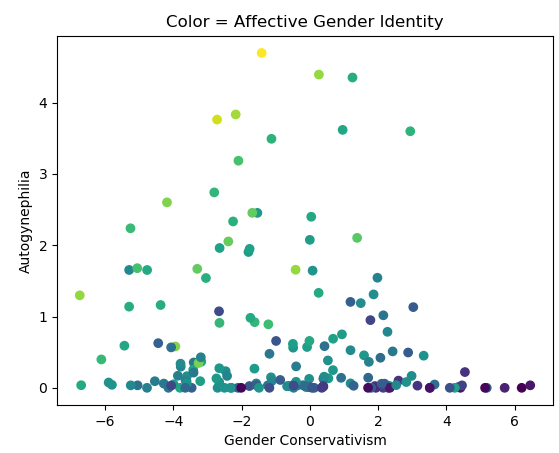
For identifying other causes of affective gender identity, it matters a lot whether autogynephilia is causally upstream or downstream of gender identity, because if it is causally upstream of it, we can condition on or control for autogynephilia, and thereby increase our statistical power, whereas if it is causally downstream, conditioning on autogynephilia would introduce biases and reduce our statistical power. For this study, I tried both kinds of analysis.
Basic approach
I first did a prescreener survey, recruiting 322 cis men on Prolific and asking them:
- To confirm that they are cis men, removing the respondents who reported being trans or gender questioning[1]
- To rate their affective gender identity on two questions about it
- To answer some questions about sexuality, including two questions assessing autogynephilia asking them how arousing they would find "Imagining being transformed into a woman" and "Wearing women's clothes; crossdressing"
Since I already knew from other research that autogynephilia was a major factor in gender identity, I was most interested in what factors might affect gender identity in the non-autogynephiles. So among the men who reported no signs of autogynephilia, I took the ones who had scores that were particularly trans-adjacent and particularly cisgender on the affective gender identity measure, and asked them if they could think of any differences they had from other men that might make them feel like that.
Based on the qualitative responses to this survey, as well as the qualitative responses to some past surveys where I had asked some similar questions, I came up with 110 questions that might assess the sorts of things men mentioned as relevant factors. Those questions were for instance things like "Which parent spent more time raising you while you were growing up?", "How psychologically different do you feel men and women are?" and "Do you tend to be open about your emotions?". I then did a survey asking 193 of the men those questions, to hopefully find some patterns in what correlates with gender identity.
A scree plot suggested that there were roughly three major factors involved in this:
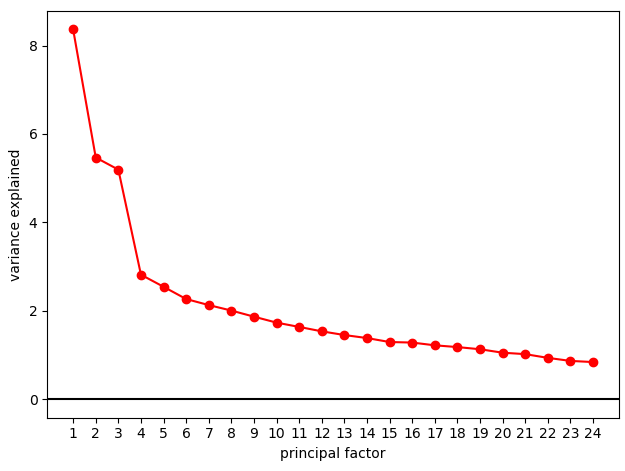
When looking at the items for each factor, I concluded that they might best be named:
- Gender Conservativism (covering e.g. questions like "Do you think it is important for men to be manly and women to be womanly?" vs "Do you believe women can do anything men can? (Other than physical strength)")
- Eccentricity (e.g. "Did you have unusual, "outsider", interests as a kid?" vs "Are you married?")
- Extraversion (e.g. "Are you good at understanding how other people feel?", "Do you tend to be open about your emotions?", "Are you good at flirting?" or "Do people around you see you as a leader?")
I was a bit unsure how to name the third factor. It seemed to include elements of emotional warmth as well as outgoing charismatic tendencies. Some people see the former as being "feminine" and the latter as being "masculine", but in personality research it is well-established that these tendencies correlate with each other, which is sometimes attributed to there being a common factor of "Extraversion" which makes people act more or less social overall. Therefore I named it "Extraversion". The full table of "factor loadings" that quantifies how much each of the questions depend on each of the factors can be found here or in the supplement.
Because it might be of interest to evaluate whether there is a distinction between the "feminine" elements and the "masculine" element of Extraversion, I separated the items into the two groups, and thereby constructed two factors, "Emotional Expressiveness" (e.g. "Are you good at understanding other's emotions?" and "Do you tend to be open about your emotions?") and "Social/sexual Assertiveness" (e.g. "Do people around you see you as a leader?" and "Are you good at flirting?"). Furthermore, I also subtracted them from each other, yielding an axis that I called "Interpersonal M-F" which captures one's lean to one side or the other.
Gender conservativism was slightly negatively correlated with Eccentricity (at around -0.15), but otherwise the main three factors were basically independent. If we instead split the Extraversion factor into its "feminine" and "masculine" components, then the M-F axis correlated positively with Gender conservativism and negatively with Eccentricity. Gender conservativism was also strongly correlated with aversion from being a woman, at a strength of 0.44, which at the time was comparable to the 0.48 of autogynephilia.[2] The strong correlation between Gender conservativism and Gender identity accounted for basically all the relationship between the factors and Gender identity; while Interpersonal M-F also correlated with Gender identity, the correlations look relatively compatible with it mostly just being confounded by Gender conservativism. Or you can see the correlation matrix below:
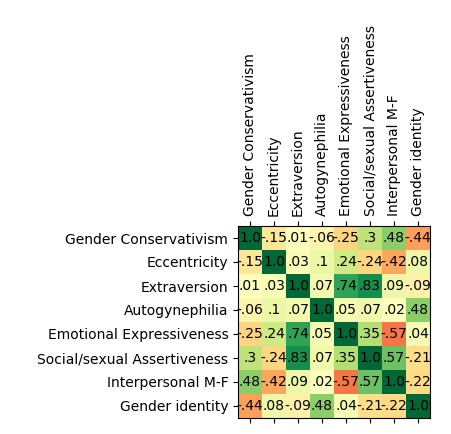
It should be noted that the "Gender Conservativism" factor doesn't just include ideological views. It also includes tendencies like getting offended if people think you are gay, enjoying locker room banter, feeling good at fights, liking guns, feeling like men are better for the world and are smarter than women, and other things that could perhaps be called "Macho"/"Machismo". So in a sense, the key finding here is that macho men are less likely to want to be women, which people might have regarded as obvious.
Similar to the case with Autogynephilia, this does raise the question of direction of causality. Is Gender conservativism/Machismo correlated with Gender identity because Gender conservativism makes men more satisfied with being male (or similar causal structures, e.g. because it makes them repress/deny whatever gender issues they might have)? Or is it instead correlated with Gender identity because men who feel good about being male are better able to see the appeal of Gender conservativism? I'm less certain about the direction of causality here than I was with Autogynephilia, but I suspect that the causal direction goes Gender conservativism -> Gender identity, for mainly four different reasons:
- In the qualitative study, the men tended to mention it as a potential factor, so whatever introspective evidence they have for it seems to suggest that it is relevant. I consider this only weak evidence, as they also proposed the many other things under the Eccentricity and Extraversion factors which didn't seem very relevant. But if one wanted to make check for stronger evidence, one could do further qualitative research, asking them why they came to the conclusion that Gender conservativism matters for their Gender identity.
- Gender conservativism seems in many ways like the sort of thing that might matter for Gender identity. Gender conservatives tend to celebrate manhood and be judgmental towards gender-bending; if you are a man who sees manhood as something aspirational and genderbending as something degenerate, then it seems like you would be averse to becoming a woman, whereas if you are a man who sees men as being toxic and genderbending as something to be promoted, then it seems like you would be less averse to it.
- I think causality tends to flow from "bigger", "more varied" factors to "smaller" factors. And in this case, I think Gender conservativism is "very big"; it has profound implications for your perspective on many important social issues, and it has strong links to lots of big things such as your social network, to the point where the culture of your ideological opponents can be like dark matter, invisible due to lack of interactions. Meanwhile, within the ordinary range of Gender identity, where one is not transitioning, Gender identity does not seem to have much opportunity to have big effects.
- You might wonder if there couldn't be a third factor causing both, but note that the correlation is very big, so a third factor causing the correlation would have to be a dominant factor in determining both of the variables, which seems implausible/hard to think of.
Also of interest, men who felt they were nerdy were much less gender conservative. This is actually very interesting to me, because the question that first set me researching all these transgender topics is, why are there so many trans women in nerdy groups such as rationalists? Until now, I had mainly seen two answers. One theory which was popular in the rationalist trans community was that nerdiness reflected some sort of "unmasculinity", perhaps a lower amount of brain masculinization, and that this lead to gender issues. Meanwhile, the theory I've seen from autogynephilia theorists such as Michael Bailey is that nerdiness was particularly related to autogynephilia. These results make it seem like both sides are wrong, and it is instead a question of nerds being more open-minded about nontraditional gender notions.
Finally, to clarify the concept of Gender conservativism, it might be nice to have in-depth description of people's views for different levels of Gender conservativism. Luckily, I did a qualitative survey asking people across the Gender conservativism spectrum to describe their beliefs. Here are the beliefs from someone who was radically Gender conservative:
I am a Muslim and homosexuality is not tolerated in Islamic societies and cultures. Gays and lesbians both go against Allah's natural disposition (fitrah) in humans - and also in animals - in which the male is drawn to the female and vice versa. The spread of homosexuality and lesbianism has resulted in diseases that neither the east nor the west can deny exist. Homosexuality and lesbianism cause family breakdown and cause people to abandon their jobs and studies because they are preoccupied with these perversions.
With being Muslim and following the teachings of Islam, you cannot be gay and Muslim. Islam is a complete way of life, you cannot amend it, you cannot change it. I agree that homosexuality should be accepted in society, but I don't want it to interfere with my religion by people claiming to be Muslim and gay. It's a sin in my religion, full stop.
To summarise, LGBTQ, homosexuality, and other forms of homosexuality are all prohibited in Islam, so instead of engaging in practises that Allah has deemed Haram for you and will lead to your destruction, follow what Allah has deemed Halal for you as it will lead to your betterment and salvation.
Meanwhile, here are the beliefs from someone who was radically Gender progressive:
If asked to describe my views I would say I am a progressive, liberal individual who takes a left leaning stance on issues relating to gender. I am a feminist who believes in gender equality. I do not have any issues with transgender people, I respect them greatly in the face of the abuse they seem to receive and I despise those with large platforms who use it to be anti-trans (e.g JK Rowling). Myself, I am not a particularly masculine person and found it difficult growing up at times at school and college. As adult it has made me more drawn to disliking hypermasculine men, criticising toxic masculinity and other poor behaviour and hanging out with other friends who are not macho men.
The people in between these extremes were highly heterogeneous; they might for instance believe that men and women had very different mindsets for biological reasons (which is Gender conservative) but that this made women more suited for certain roles that are traditionally male, such as politicians (which is Gender progressive). Alternatively, they might believe that the whole topic is blown out of proportion and that people should instead pay more attention to practical matters.
Another way to get an impression for what the gender conservativism variable amounts to is to look at how the different levels of gender conservativism map to the question responses. In the diagram below, I've plotted a histogram for gender conservativism, and below the histogram I show a select set of items that assess gender conservativism (shortened for space purposes). Next to each item, I show the response options for the questions, with each response option being placed under the range of gender conservativism where people are most likely to pick it:
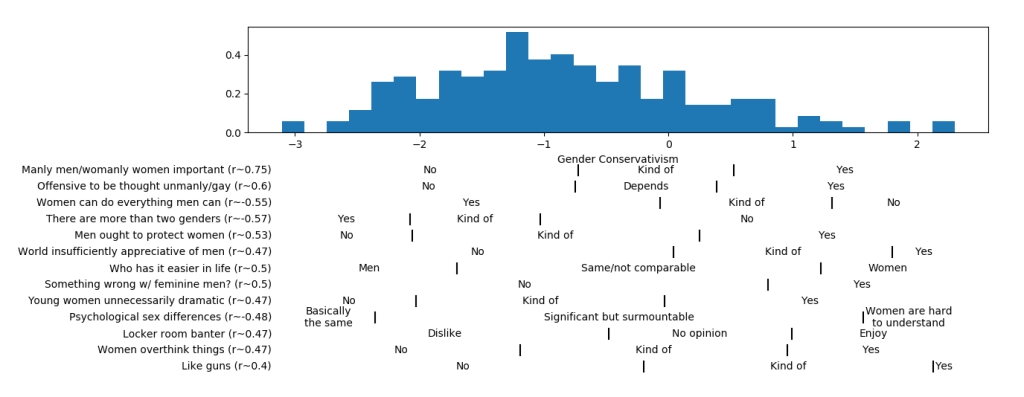
About masculinity/femininity and mental health
This survey still left about half the variance unexplained. It would be much better to have a deterministic model of gender identity, as that makes a lot of research questions simpler. I tried a few improvements by e.g. asking additional qualitative surveys of men who had more or less gender issues than would be expected from their Autogynephilia and Gender conservativism scores if they could come up with any suggestions, but they didn't really have much to say.
Since I didn't really know what else to do, I thought I would investigate the short-term stability of the factors over time, as well as various characteristics that have often been speculated about as being relevant for transsexuality, such as[3] masculinity/femininity and mental health. Trans women tend to feel much more feminine than cis men do, so likely this would also be linked to gender identity in these surveys. Furthermore, trans women are often anxious or depressed, and various mental health problems like body dysmorphic disorder or obsessive-compulsive disorder have been proposed to contribute to gender dysphoria. Finally, the theoretically-inclined trans women I've talked to about these topics often talk about autism or dissociation as being related to gender dissatisfaction.
I've put a lot of effort into measuring masculinity/femininity in the past, and my impression so far has been that it's a very subtle problem, because the things people verbally mention to define masculinity/femininity doesn't align all that well with who they'd actually label as masculine/feminine. I really should do an in-depth writeup about this at some point, but until then I recommend this animatic showing how women can be very feminine even if they nominally fit the definition of being very masculine, or this critique at Unremediated Genderspace.
So in order to measure masculinity/femininity, I had to use incomplete, ad-hoc means. This mainly meant two things. First, there is a masculinity/femininity test I have been working on, which aims to measure what people informally think of as being masculine/feminine using concrete descriptors, so I took some items from that. Secondly, one way to assess the masculinity/femininity is to just ask people how masculine/feminine they are; this is arguably guaranteed to measure their own notion of masculinity/femininity, at the expense of potentially making the measurement heterogenous (meaning different things for different people) and opaque (difficult to know what exactly it is that you are measuring). So by doing both, I came up with a varied set of questions.
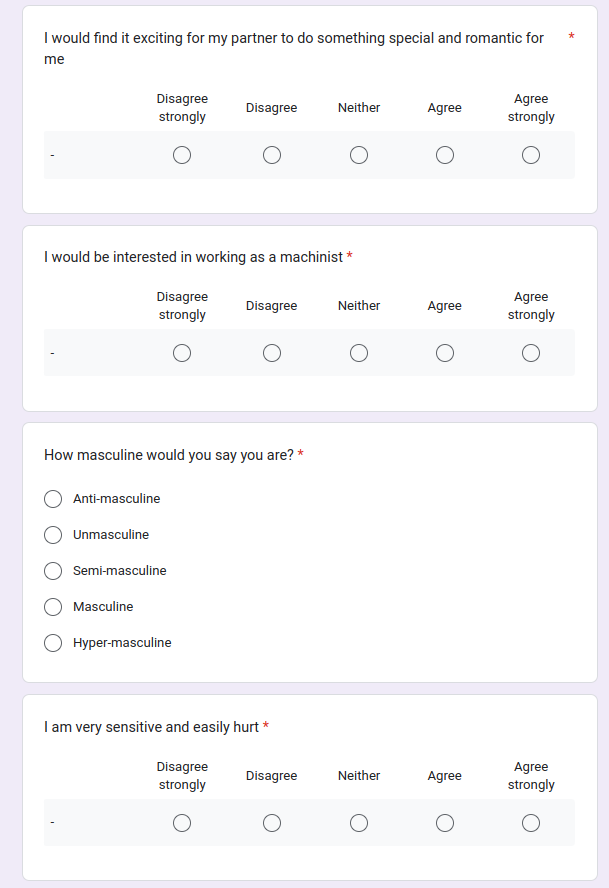
Some of the questions used to assess masculinity/femininity, as they were presented to the respondents.
When looking at the correlations, my items from the masculinity/femininity test (marked with "MFPERS:") were often related to how masculine/feminine people felt they were, rated abstractly (labelled as "Self-Assessed M-F"). This is good as that is what the masculinity/femininity test was designed to do.[4] However, they were generally not related to Gender identity, with perhaps a few exceptions. However, while the MFPERS items were not very related to Gender identity, Self-Assessed M-F was fairly strongly related to Gender identity:
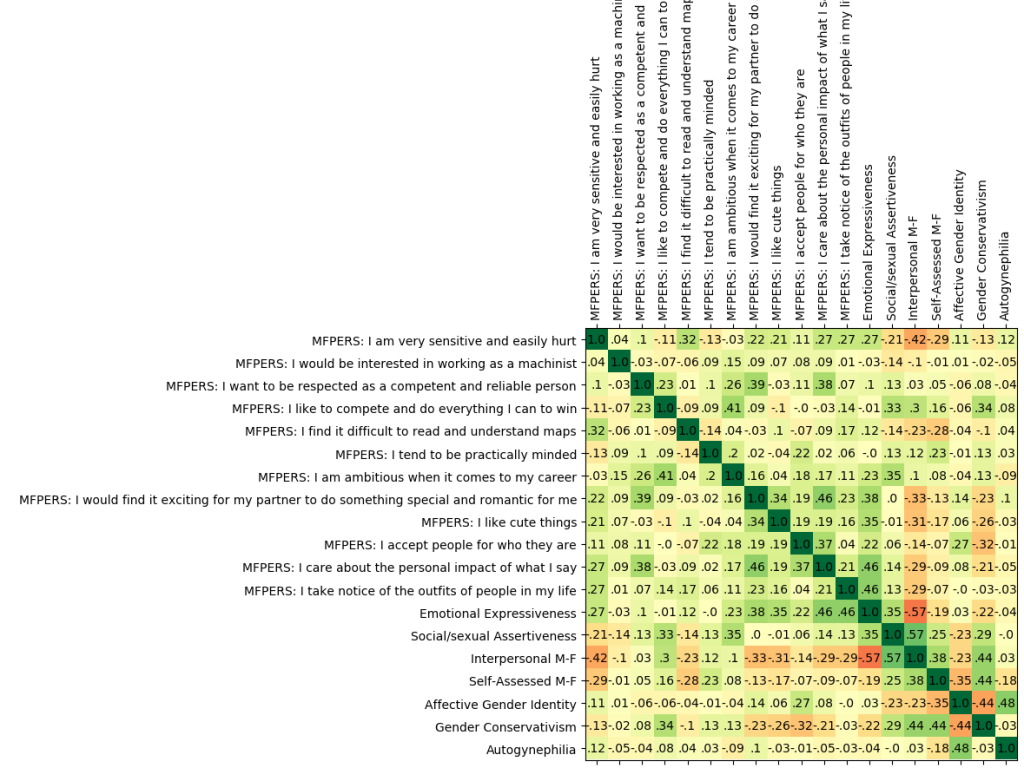
However, if we buy the argument of Gender conservativism/Machismo and Autogynephilia being relevant root causes, we might imagine that e.g. Autogynephilia both makes a man feel more feminine and feel more like he wants to be a woman. If this is the case, then they would induce a correlation between Self-Assessed M-F and Gender identity. It's a bit of a philosophical question whether this induced correlation represents a real correlation between True Masculinity/Femininity and Gender identity, as that requires deciding whether Autogynephilia is feminine/Gender conservativism is masculine. However, it does make me interested in whether there are any connections between Self-Assessed M-F and Gender identity beyond those induced by Gender conservativism and Autogynephilia. We can achieve this by subtracting off Gender conservativism and Autogynephilia from all the items, leading to this correlation matrix:
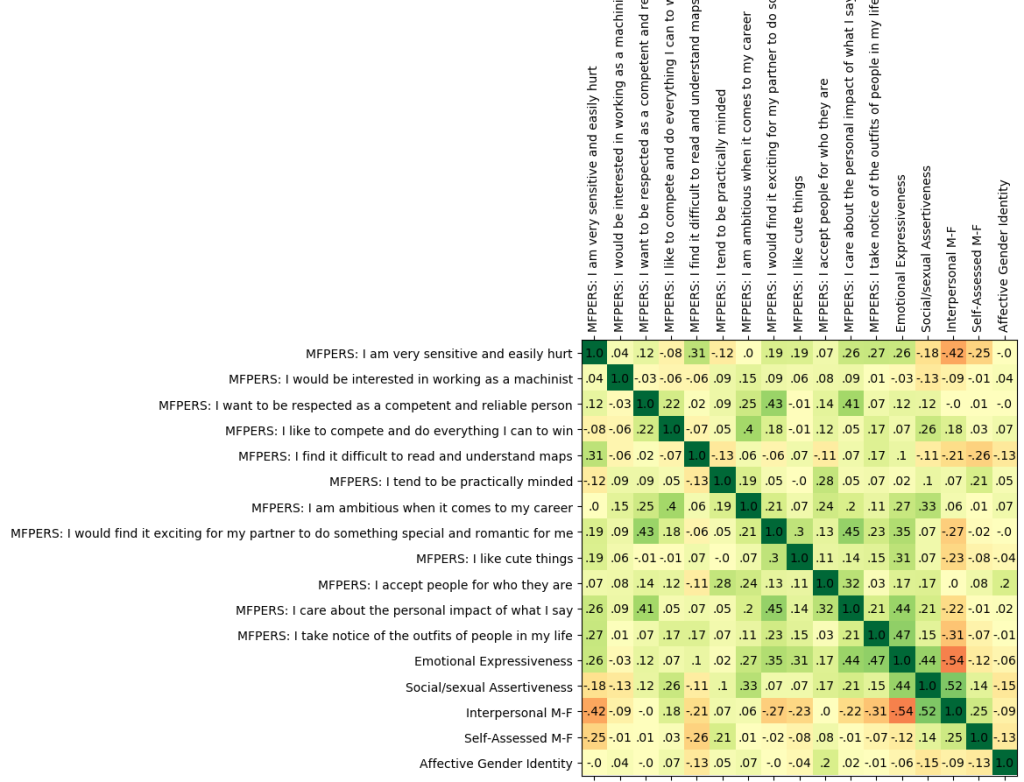
When controlling for these factors, most of the correlation between Self-Assessed M-F and Gender identity goes away, so if Gender conservativism and Autogynephilia are root causes, that suggests that maybe there is not much value in Masculinity/Femininity-related factors in explaining Gender identity in the ordinary range of variation in gender identity. That said, there are a few remaining correlations that it might be worth investigating further.
Next, there's the question of mental health. Unfortunately I did not have the resources to do a rigorous mental health assessment of the participants, so instead I used two ad-hoc measures. First, in this survey, I wrote brief descriptions of each condition, and asked people whether the descriptions applied to themselves. For instance, here is a screenshot of two questions I used:
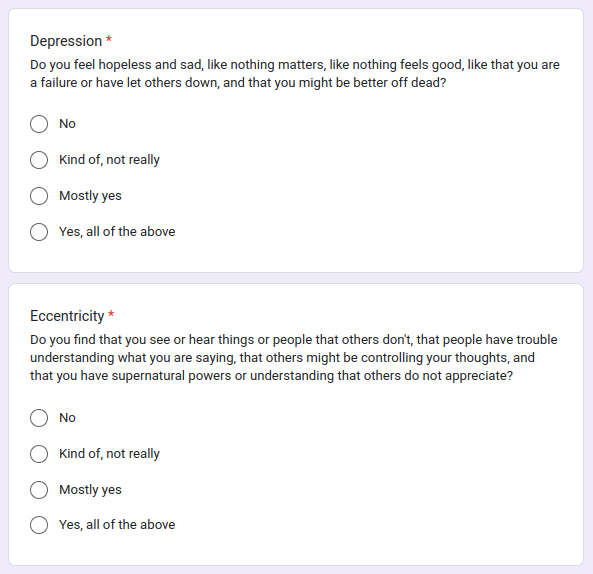
The full list of conditions I wrote was:
- Depression: Do you feel hopeless and sad, like nothing matters, like nothing feels good, like that you are a failure or have let others down, and that you might be better off dead?
- Anxiety: Do you mostly feel nervous, unable to control your worrying, having trouble relaxing, and feeling something awful might happen?
- Body image: Do you feel bad about your body, avoiding activities to hide it or obsessing over its flaws, are you considering extreme interventions to change your body, feeling inferior to others because of your appearance?
- Unstable identity: Do your relations to others rapidly change between feeling like the other people are great and terrible, do you have binges where you go all-out with excessive acts, do you have regularly have frantic efforts to avoid abandonment, do you feel unsure about what you truly believe in?
- Eccentricity: Do you find that you see or hear things or people that others don't, that people have trouble understanding what you are saying, that others might be controlling your thoughts, and that you have supernatural powers or understanding that others do not appreciate?
- Autism-like traits: Do you find yourself to be asocial, to tend to notice specific details and patterns, to have trouble understanding other's mental state or how to interact with others, and to tend get obsessed about your activity or special interests?
- Obsessions/compulsions: Do you have some theme that you keep having unwanted thoughts about, where you feel you have to engage in certain behaviors to feel comfortable, and where you otherwise cannot control your thoughts about it?
- Depersonalization/dissociation: Do you find that you aren't sure if events are real or happen in dreams, that you miss parts of conversations, that you end up in places without being sure how you got there, do you feel that you yourself or other people seem unreal, and that your body is not your own?
Furthermore, in a later follow up survey, I also asked people whether they had been diagnosed with any of a range of mental health conditions. I included response options for both suspecting that one has it while not being diagnosed, for having self-diagnosed, and for having been professionally diagnosed, and counted people increasingly as having the condition the later of the options they picked. The correlations between the variables considered so far looks as follows:
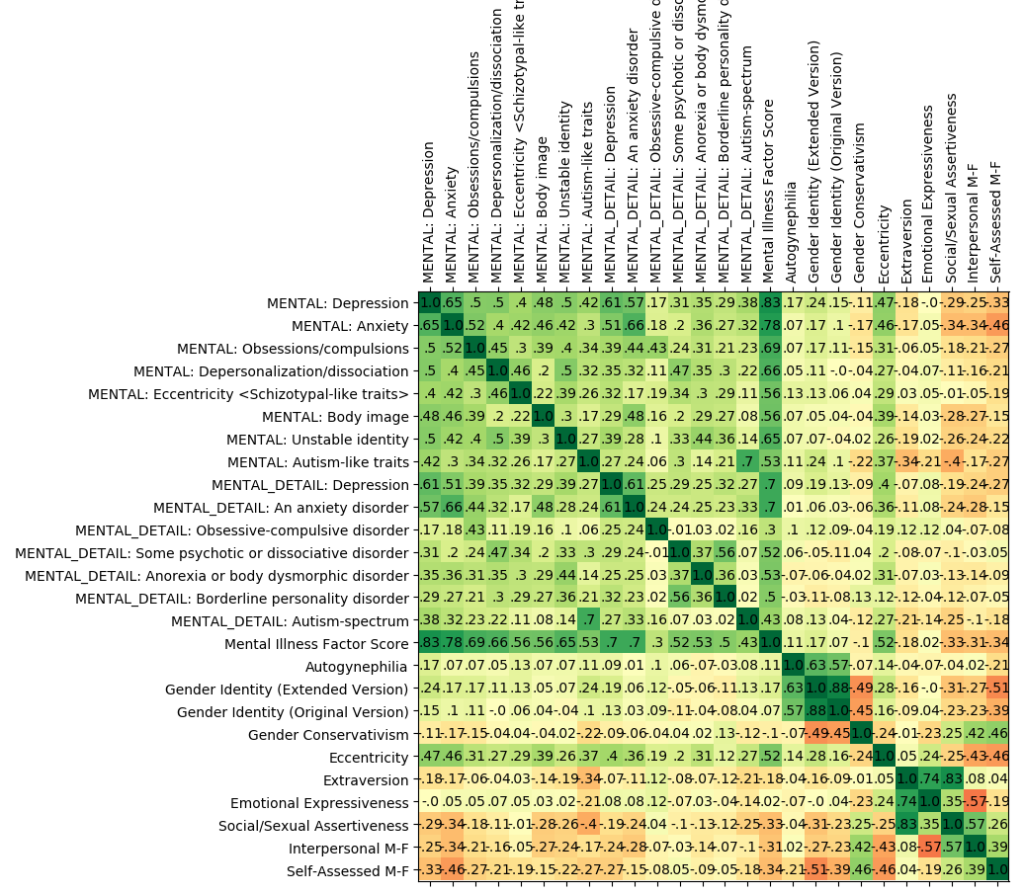
Sometimes, there was reasonable correlation between the two methods of assessing mental health problems; for instance, autism was highly correlated across the methods. Other times, such as with depression/anxiety, there was strong correlation across the methods, but also a lack of specificity; self-ratings as fitting the description of depression were correlated not just with depression diagnoses but also with anxiety diagnoses.[5] Meanwhile, some measures performed quite poorly; for instance, the "Body image" variable was supposed to assess the same sorts of things as the "Anorexia or body dysmorphic disorder" diagnosis, but it didn't.
Overall, mental illness wasn't that strongly correlated with Gender identity. There was some correlation with depression, but that might be reverse causality; I could imagine that a man who is happier and prouder about being male would be less depressed as a result. There was no correlation with body image problems. You might think that is surprising because Affective gender identity involves Gender dysphoria, but I think it makes sense. First, male body image problems often manifest in feeling that one should be more muscular, and secondly, Gender dysphoria is rare and only really appears at the far trans end of the gender identity range, so while trans people are often dissatisfied with their appearance, it wouldn't necessarily be expected to appear in the normal range that I am studying here. Autism and anxiety were some remaining variables that correlated a bit with Gender identity. I did not investigate them much further, because the correlation wasn't that strong and I've tried looking into it in the past with only limited success, but it might be worth looking into them more thoroughly in the future.
Note that just because mental illness isn't that strongly correlated with Gender identity, that doesn't mean that it's not going to be connected to transsexuality. For instance, you could imagine that metal illness lowers the threshold of Affective gender identity that leads to transition, or that an unfulfilled wish to transition causes strong mental difficulties. We'd probably need a really big longitudinal study to know for sure.
One thing that was interesting to me was that the Eccentricity factor that we accidentally discover earlier turned out to be highly correlated with mental illness. This is interesting to me because the Eccentricity factor mainly contains questions related to experiences, lifestyle and beliefs about things, while mental illness mainly concerns internal feelings. Often, these sorts of things are studied in isolation, but the fact that there is such a strong correlation suggests that the world that mentally ill people live in is very different from the world that mentally healthy people live in, across a wide variety of areas. This is perhaps not so surprising, but I think it is something that often does not get properly investigated in the psychopathology research I've seen.
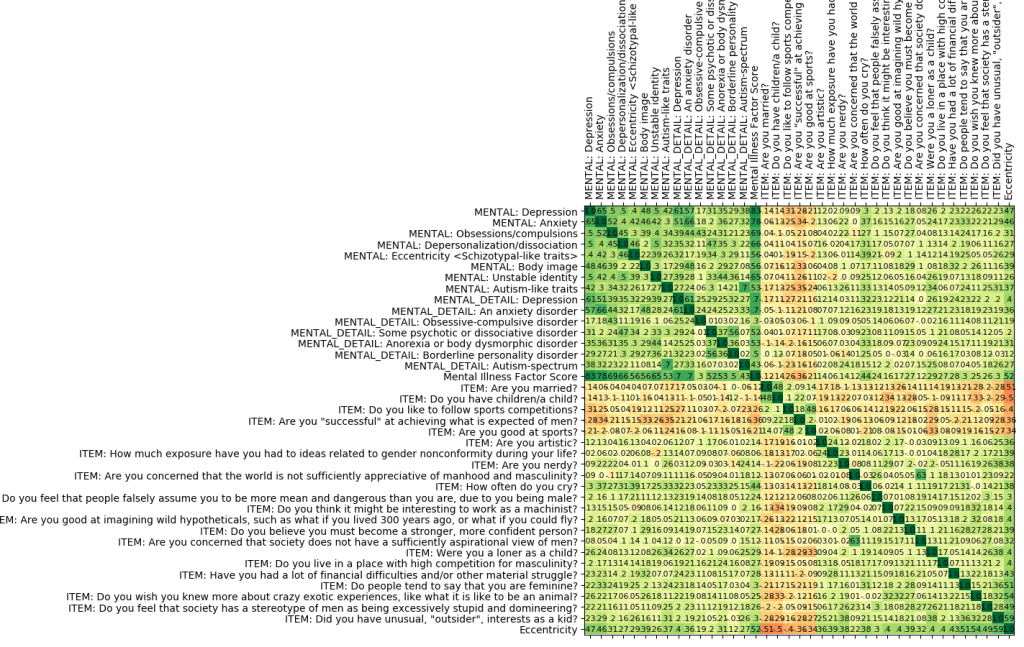
Above, you see the correlation matrix between mental illness items and eccentricity items. I don't really notice any patterns of major interest, but I thought it would be worth including it, so that it is more clear what exactly it is that is correlating.
Are there consequentialist gender issues?
Among rationalists, "consequentialism" is a term used to refer to reasoning that looks at the consequences of different options, and then recommends picking the option with the best consequences. It is a fundamental principle of agency, as it tends to lead to achieving the consequences one is searching for. As such, it seems a priori plausible that consequentialism would play a role in gender identity, as being male or female has different consequences, and people might be taking those consequences into account.
To investigate this, I've previously done some research to find the consequences that people consider to be the biggest advantages for men and women respectively. The things that my male survey respondents on average considered to be advantages for being male over being female appeared to be (in no particular order):
- Power in society: Men have higher income, more representation among political decision-makers, and are more likely to be assumed to be higher-ranking in interactions
- Sociosexual attention: Women often get a lot of attention from men who want to have sex with them, which may be inconvenient
- Sexual assault worries: Women have more risk of facing sexual violence
- Sexual attractiveness competition: Women compete a lot on physical attractiveness, and this particularly depends on being skinny and youthful-looking
- Periods: Women have to deal with menstruation
- Physical vulnerability: Women are more physically vulnerable than men; are surrounded by men who could beat them up
- Childbirth: In order to have children, women get pregnant and go through childbirth
- Feminine presentation: Women are expected to wear feminine clothes, makeup, and similar
- Female childcare: Women are expected to take care of children, often at the detriment of their career
- Coarse male anatomy: Men have more body hair, are more smelly, have their fat on their bellies, and have penises as external rather than internal sexual organs
- Utilitarian male anatomy: Men are stronger than women, can pee standing, and find it easier to reach orgasm
Meanwhile, the advantages for women over men as evaluated by men appeared to be (again in no particular order):
- Male femininity: Women are allowed to wear feminine clothes, makeup and similar, and are not required to have macho gender conservative views
- Toughness: Men are expected to be be tough, hide their feelings, be ready to fight, and not cry
- Men assumed not to care for children: That men are assumed to not be capable of nurturing, and are potential child predators
- Female friendships: Women are considered more approachable by others, and tend to have closer friendships with each other than men do
- Male gender norms: Men's success may be judged on their careers, and they are expected to know technical things and be good at sports
In order for these concerns to have the potential of generating variation in Affective gender identity, they must themselves vary. There are multiple ways that can happen; for instance, maybe one has unusual preferences about what outcomes to achieve (e.g. maybe a househusband is less interested in having power in society), or maybe one is in an unusual environment where the factors do not apply as much (e.g. maybe one lives in a place where women are not expected to wear feminine clothes). In order to attempt to measure the overall effect, I asked the participants to rate the extent to which these factors would leave them better off as men or as women, and instructed them to include both personal preferences, beliefs, environmental factors, and whatever else might affect their evaluation. I'm not sure if this is a good approach, and perhaps some further psychometric investigation would be better, but for now this is what I have data on.
The attitudes to some of the factors had a very strong consensus; for instance, most men felt that the risk of sexual assault would be a downside for them if they were women. Others were highly varied, for instance there was a lot of disagreement between men on how attractive the sociosexual attention would be, with a substantial minority feeling like it would be an advantage. Still others were fairly undecided, e.g. most men did not in net care one way or another about the coarseness of male anatomy.
For convenience, I "aligned" all the variables such that higher score = it would be an advantage as a woman, and lower = it is an advantage as a man. The correlations can be seen here:
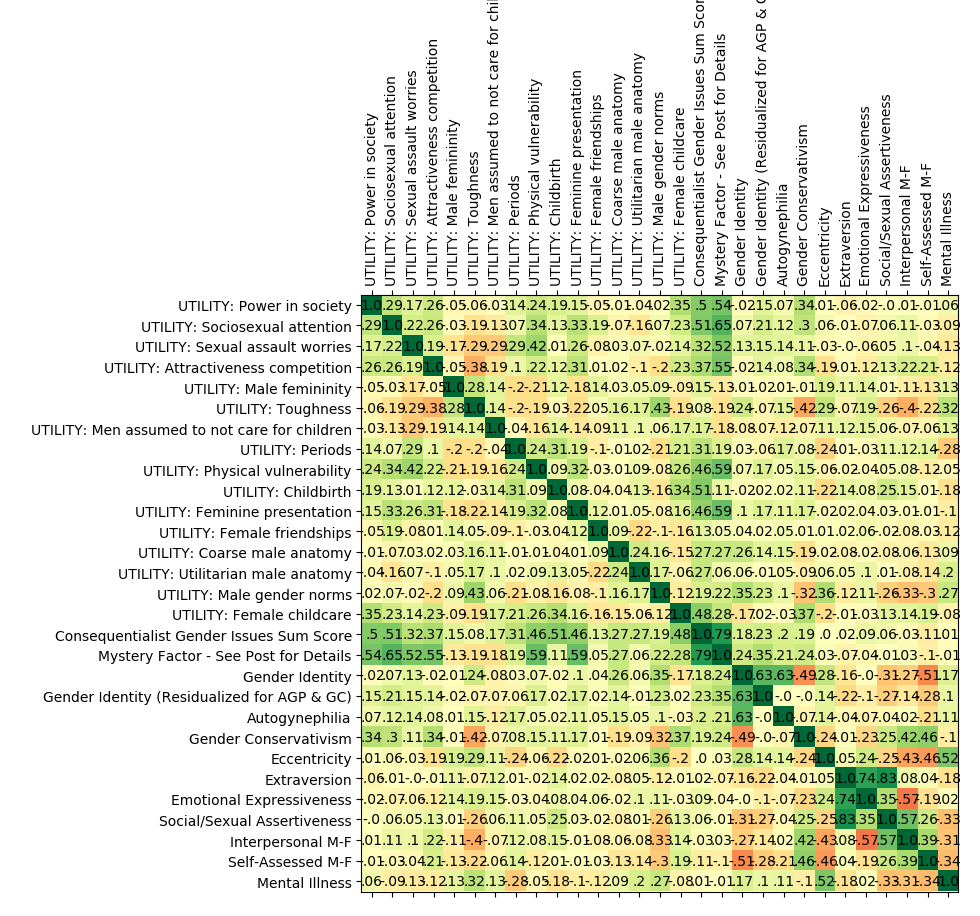
The first thing to notice is the correlation between the "Consequentialist Gender Issues Sum Score" and "Gender identity". I constructed the sum score by simply adding up all the questions about advantages/disadvantages. This sum correlated at 0.18 with Gender identity, which is not nothing, but at the same time, not much.
That said, if you look at the correlation patterns, they look kind of weird. For instance, "Power in society" - surely if you think being a woman would mean that you wouldn't get proper pay or representation, that would make you less interested in being a woman. Yet I found no correlation in the survey. A likely explanation appears if you look at how "Power in society" correlates with other variables - namely, it correlates with Gender conservativism. Indeed, one of the core principles of Gender conservativism is that feminism is overrated, which tends to include beliefs that gender inequality is not a problem for women. Of course Gender conservatives would therefore be more likely to say that "Power in society" would not disadvantage them if they were women. And we know that Gender conservative men are less likely to want to be women, so this represents a potential confounder, eliminating the correlation that we'd otherwise expect between feeling that women are better off and wanting to be a woman.
Assuming we buy my causal story, I fix this with the "Gender Identity (Residualized for AGP & GC)" variable. Here I subtract off Autogynephilia and Gender conservativism from Gender identity, leaving a variable that is uncorrelated with both. Now it turns out that this variable has a very different pattern of correlations with perceived advantages/disadvantages to being a woman; namely, "Power in society", "Sociosexual attention", "Sexual assault worries", "Attractiveness competition", "Physical vulnerability", and "Feminine presentation" started correlating more, while "Toughness", "Coarse male anatomy", and "Male gender norms" started correlating less.
Now, the diagram also contains a "Mystery Factor", and it is time I explain what it is. It is a variable I created by adding up the remaining correlating variables, that is, "Power in society", "Sociosexual attention", "Sexual assault worries", "Attractiveness competition", "Physical vulnerability", "Feminine presentation", "Coarse male anatomy", "Male gender norms". Hypothetically, potentially, this variable tags the consequentialist gender issues that actually exist. However, I would be concerned about taking it too seriously, as it is likely overfitting a whole bunch, so it probably needs independent replication. Also, it only seems to account for a fraction of gender identity, but plausibly this could be fixed through better measurement.
Beyond this, I do not see any other important patterns in the correlation matrix. Overall, this survey makes the potential for consequentialist gender issues look very limited to me.
On the measurement of autogynephilia
So far, I have not really gone into detail about how I am measuring autogynephilia, so I thought I should do that. In most of the surveys, I added some basic measure of autogynephilia in order to make sure that I could capture the persistent elements of it. This involved asking people about how sexually arousing they would find various autogynephilic things, on a scale of "Not at all", "A little", "Moderately", "Quite" or "Very":
- Imagining being transformed into a woman
- Wearing women's clothes; crossdressing
- Imagining that you are a woman and have sex with another person
- Imagining that your body magically transforms to become female
- Imagining being a woman and having lesbian sex with another woman
Items like the above (especially "Imagining being transformed into a woman" + "Wearing women's clothes; crossdressing") are how I've usually quickly and briefly assessed autogynephilia among cis men. In one of the surveys, I also asked about frequency of sexual fantasies involving the following themes:
- Imagining yourself as a woman in the sexual fantasy
- Crossdressing; wearing women's clothes
The responses to autogynephilia items like the above are typically highly skewed; a lot of men report no autogynephilic sexuality at all, and the sexual interest of the remainder are somewhat evenly split across all the levels of response options. For example, here's the response distributions for some of the items:
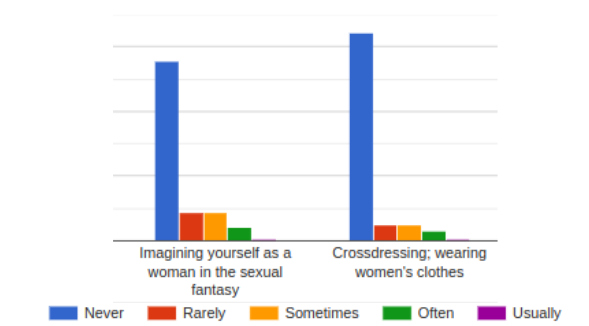
In another of the surveys, I had items meant to assess the five kinds of autogynephilia that are traditionally listed by autogynephilia theorists, to work as a screener for a more comprehensive survey on autogynephilia in case there are some who are not into the previously mentioned types of autogynephilia. They asked about arousal to the following:
- Having a female body or female body parts
- Wearing women's clothes or makeup or other feminine accessories
- Having female physiological functions, such as menstruating, lactating or being pregnant
- Being seen as a woman by others, or having sex with a man as a woman
- Behaving in a feminine way, or entering feminine spaces
In order to make it unambiguous that the participants were supposed to answer based on their sexuality, I tried to make sure I could place it among other questions inquiring about sexual interests, such as "Having sex with a woman". You can see the correlation for these questions here:
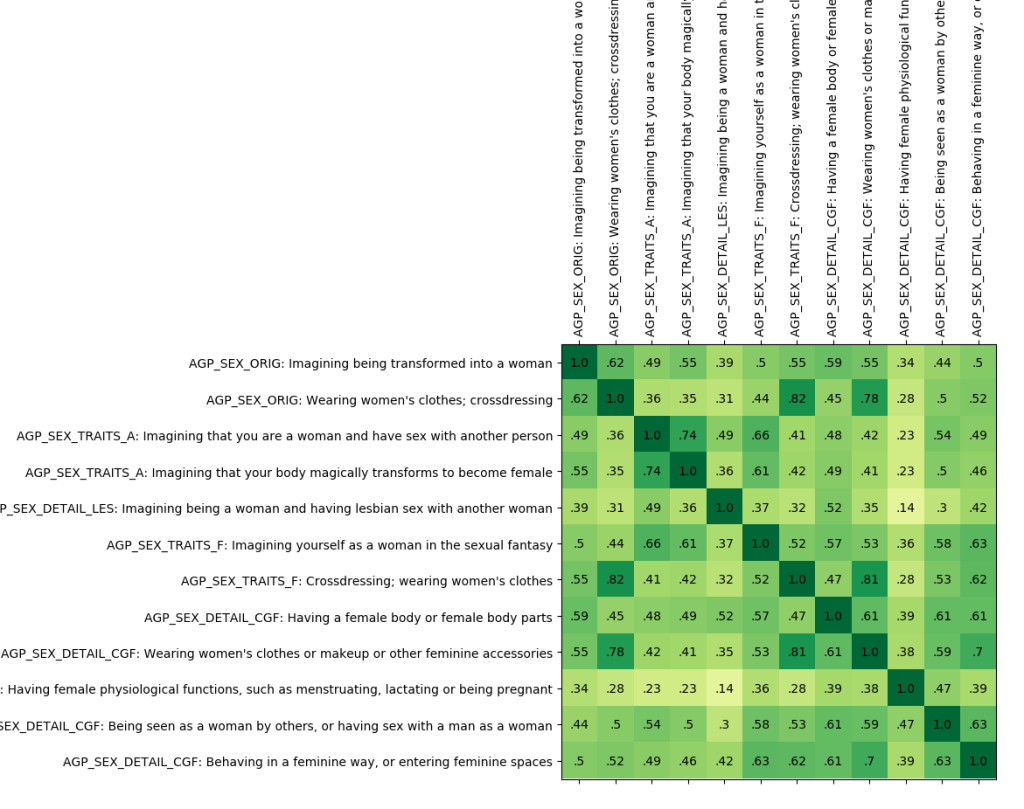
However, the above questions could be criticized in various ways. They were presented as just a brief part of a bigger survey, so maybe the respondents didn't think properly about them since it's not the main part of the survey. They almost exclusively asked participants how "sexually arousing" they would find some scenario - does this square well with other notions of autogynephilia? And the questions did not ask in detail about what the autogynephilic sexual fantasies involved; those would be nice to know.
To investigate these questions, I designed a survey that looks into it in more detail. It contained various measures, but to me the most important measure went into detail with the presence and impact of AGP. Specifically, I told the participants that I was doing a survey on "cross-gender fetishism", which I defined as "a sexual interest in being a woman or being feminized in sexual scenarios" as well as by giving examples of AGP fantasies. In the survey I then asked the following questions:
- What is their most erotic cross-gender sexual fantasy?
- Cross-gender sexual arousal: How sexually arousing do they find the fantasy?
- Frequency of cross-gender sexual fantasies: How often do they have cross-gender sexual fantasies?
- Exclusivity of the cross-gender sexuality / attractiveness of "normal" sexual interests: How erotic do they find scenarios that do not involve AGP?
- Onset of cross-gender sexuality: When in their life did they first start having cross-gender sexuality?
- Trajectory of cross-gender arousal: How has their cross-gender sexuality proceeded over time?
- Cross-gender sexual behavior: Have they acted on their cross-gender sexuality?
- Cross-gender erotic material: How often do they use erotic material depicting cross-gender themes?
- Self-insertion as female while using ordinary erotic material: How often do they imagine themselves as the women in ordinary erotic materials?
Note that this is just a brief summary of the questions; in practice they were somewhat more detailed, which you can see in the attached file with the question texts. For example, here are three of the questions as presented to the participants:
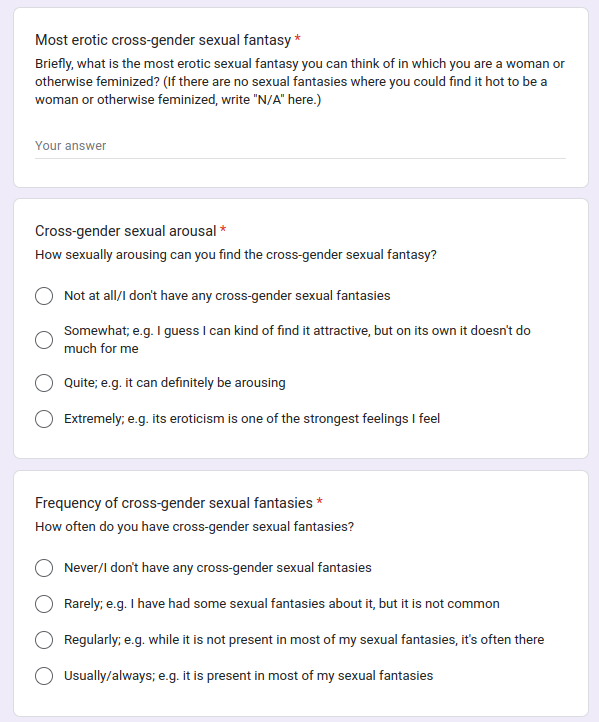
The correlation matrix for these questions can be seen below:
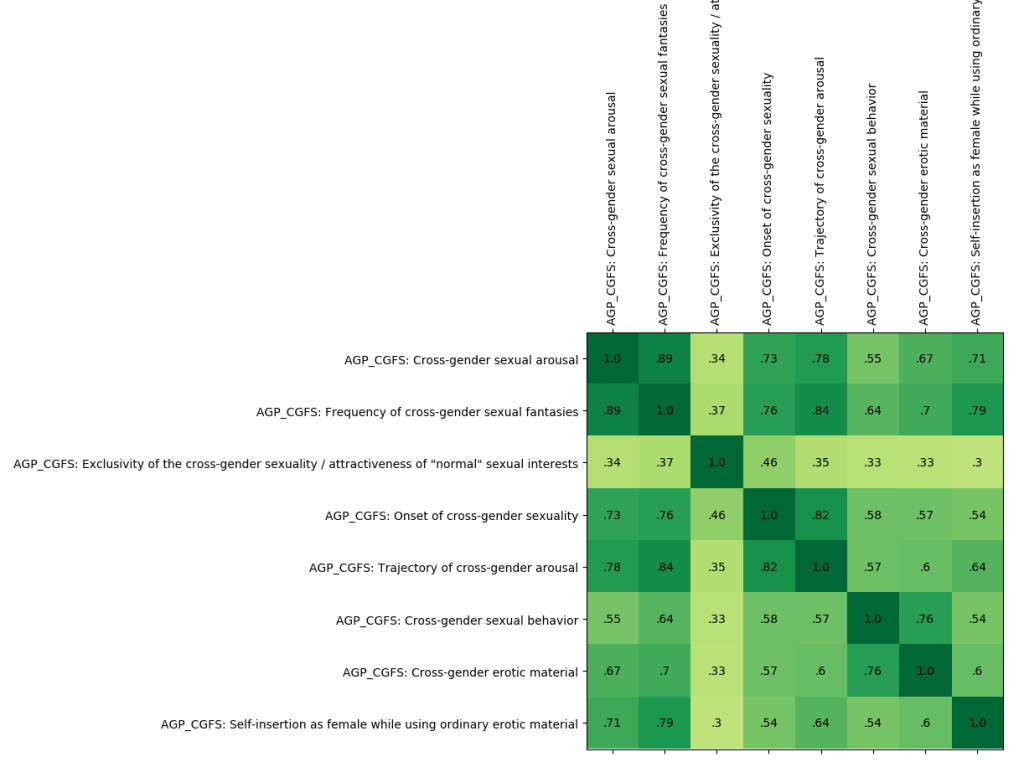
However, what I find more interesting is mapping out the relationship between these questions and AGP levels. I.e., for different levels of AGP, how do people respond to these questions?
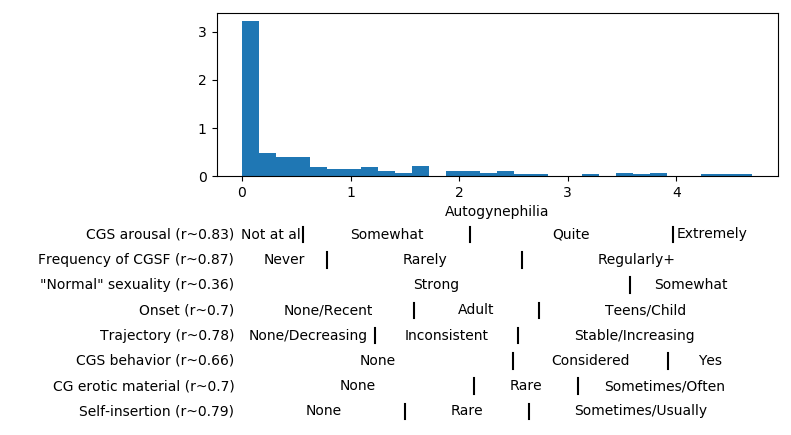
Clearly, this distribution is extremely skewed. The way I like to think of the skew is that most men - perhaps 85%-97% in representative samples, though often only 30%-70% in internet samples - are not the least bit AGP. And then the remaining men are evenly distributed in AGP levels across all orders of magnitude of AGP strength. If you are more statistically inclined, you might wonder about the true distribution; e.g. is it log-normal? This is not something I think our current measurement tools can answer, and I admit that is rather unfortunate that I cannot test it, because it is especially the tails of the distribution that matter for what we would expect to see among e.g. trans women.
Whichever way we think of it, though, I believe it is quite clear that autogynephilia is a continuum, where one can be more or less AGP. My view here differs from that of Michael Bailey, who recently on a podcast argued that autogynephilia does not exist in smaller degrees, based on e.g. research recruiting participants from autogynephilic erotic groups, where the members of such groups were much more AGP than the baseline population. The obvious flaw in such research is that obviously, the men who are more AGP have greater chance of spending time in AGP-related erotic groups, so sampling from such groups would overrepresent the rate of highly AGP men, relative to only slightly AGP men. This error is not a one-off pattern; my experience with Michael Bailey is that he constantly works on a "community level"/"group level", evaluating what sorts of people exist based on what sorts of communities exist. I've tried pointing this out, and explaining that one must reason about the selection processes by which the general population enters into such communities, but he refuses to even think about that.
Anyway, the above scale was not the only scale I included in the survey on cross-gender fetishism. I also included a scale asking people for the frequency in which they had various common autogynephilic sexual fantasies:
- You are a woman and have sex with a man
- You are a woman and have sex with a woman
- You are a woman and masturbate
- You are crossdressing, wearing women's clothes
- You are transformed into a woman (e.g. through magic, sci-fi technology, or other means)
- You are a woman, and you think about/look at your feminized body
Furthermore, in order to make my research more comparable to previous research done by autogynephilia theorists, and to get more comprehensive measurement of autogynephilia, I included Ray Blanchard's Core Autogynephilia Scale and Autogynephilic Interpersonal Fantasy Scale as well as Kevin Hsu's General Autogynephilia Scale.[6] One way we might analyze this data is by correlating the different scales with each other. That leads to the following results:
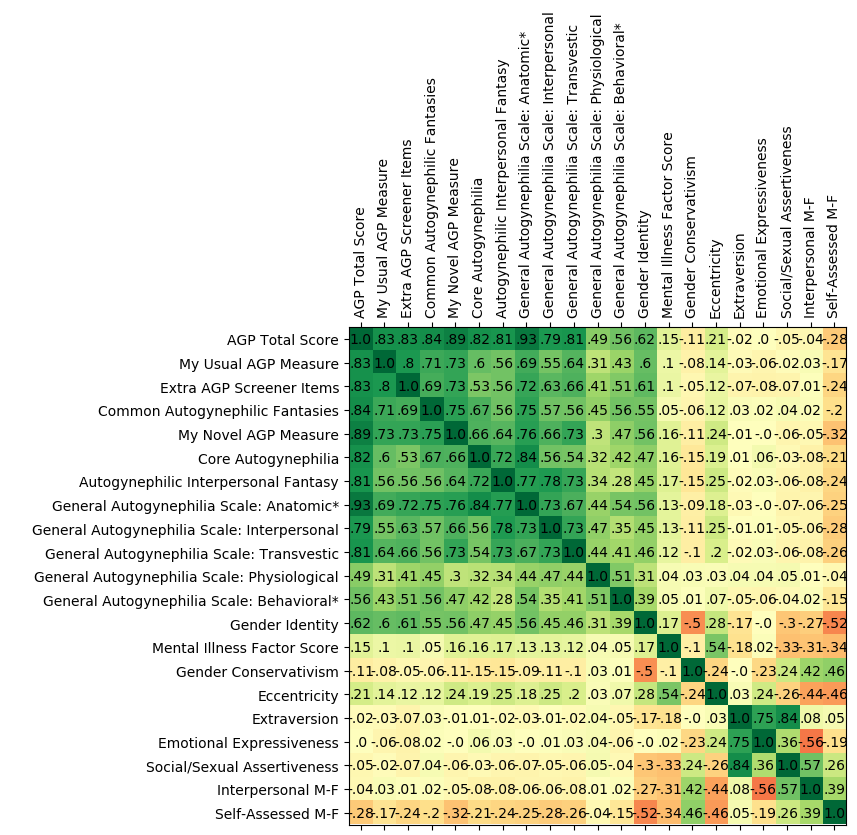
As you can see, the different scales tend to be fairly highly correlated. As such it might be tempting to conclude that autogynephilia is completely unidimensional and there isn't much need to distinguish between different measures of autogynephilia. However, there is a potential complication that appears in this. The scales are composed of multiple items, and often each scale has items with wildly different content. For instance, "My Usual AGP Measure" has both "Wearing women's clothes; crossdressing" and "Imagining that your body magically transforms to become female", which arguably assess different forms of AGP. It is possible for these to not be all that correlated with each other, while still inducing high correlations between scales that include both of those themes. To help address this issue, we might factor-analyze the AGP data on the level of individual items, to see which combinations of items are reasonable to join together. First, a scree plot to assess the dimensionality:
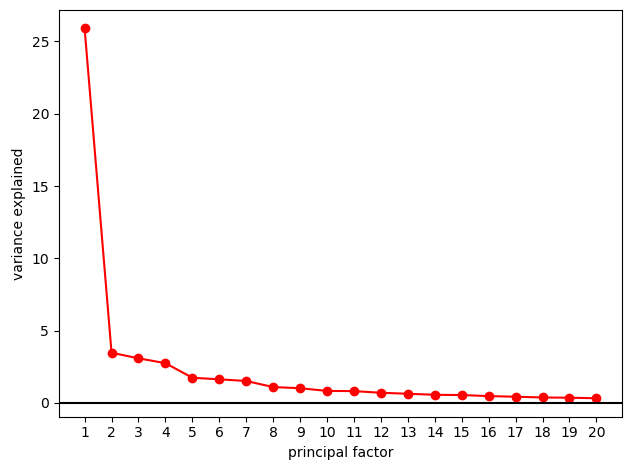
This plot shows that autogynephilia items are extremely one-dimensional. However, there might be some slight multidimensionality to them. When running factor analysis, I can find 4 interpretable factors, so that is what I ended up extracting. I ended up labelling the factors:
- Feminization/Transvestic AGP: e.g. "Crossdressing; wearing women's clothes", "Cross-gender erotic material"
- Anatomic AGP: e.g. "You became sexually aroused while picturing your nude female genitals (private parts)"
- Interpersonal AGP: e.g. "Picturing myself as a woman being admired by another person", "Picturing myself with a woman’s face"
- Physiological AGP: e.g. "Picturing myself lactating and/or breastfeeding" or "Picturing myself urinating seated like a woman" (according to the General Autogynephilia Scale, the latter would be considered behavioral, but perhaps because some of the items were missing, that's not how it was categorized by the factor analysis)
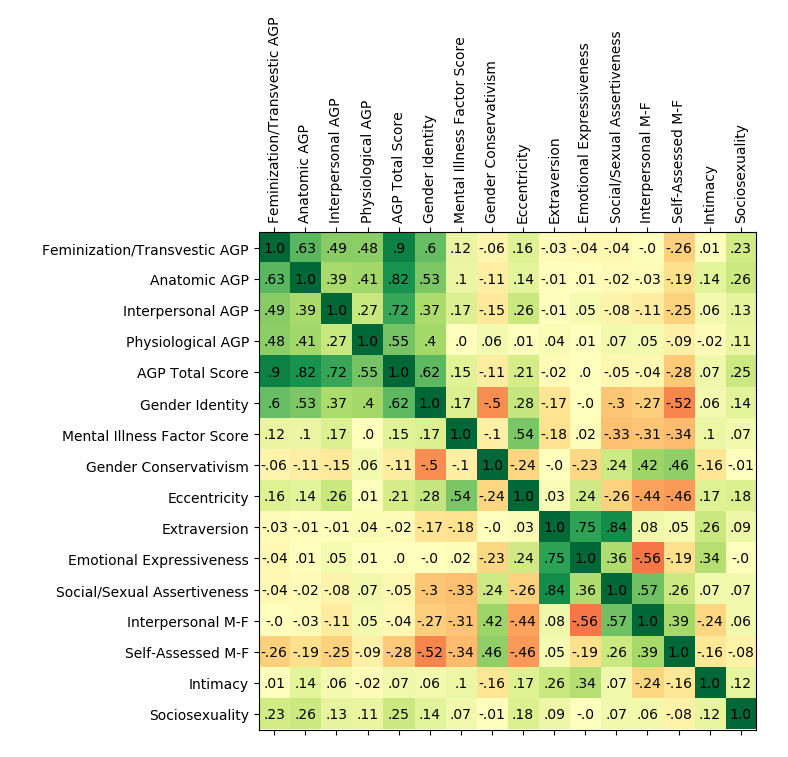
So it's actually quite possible to make AGP factors that are much more differentiated than the AGP scales that I previously showed. However, once we look at these correlations, we see something interesting: The correlation between different types of AGP are fairly comparable in magnitude to the correlations between AGP and gender identity. This raises the question of whether my insistence of distinguishing AGP from gender identity even makes sense. After all, AGP couldn't correlate more with gender identity than it correlates with itself.
But actually, the previous sentence is just wrong, or rather, complicated by different possible causal structures. Let's investigate three of them, to clarify things. First, since this is just an example, let's drop physiological AGP since it's an outlier that complicates things. Next, it seems reasonable to suppose that different notions of autogynephilia correlate with each other because there's some common underlying cause, which I will call "general autogynephilia". The details aren't yet so important, but if we assume the autogynephilia types to otherwise be independent, we can compute how strongly they each depend on general autogynephilia. Next, suppose for parsimony's sake[7] that Gender identity is only affected by one form of autogynephilia, say by Feminization/Transvestic AGP, we get this causal network:

If this causal network holds, the path marked x determines the relationship between autogynephilia and Gender identity. In particularly, if the x path was deterministic, Feminization/Transvestic AGP would be deterministically related to Gender identity, even though Feminization/Transvestic AGP isn't deterministically related to other forms of AGP.
However, we know this causal network cannot hold, because it would require Feminization/Transvestic AGP to be much more strongly related to Gender identity than Anatomic AGP is. So for contrast, let's consider another causal network:
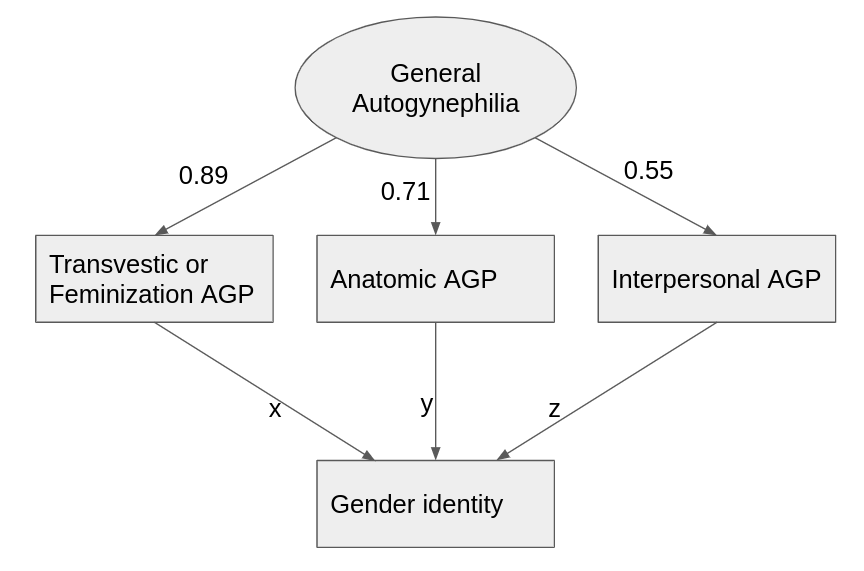
This sort of causal network has enough degrees of freedom that it could account for any relationship, including the set of correlations we see, to the point where we've captured the entire effect of autogynephilia. It could also in principle account for a deterministic relationship, where for instance the correlations between autogynephilia and gender identity would be as strong as the correlations we see between the individual facets of autogynephilia and the total autogynephilia score.
The above causal network assumes that the effect of the general autogynephilia trait is mediated by specific forms of autogynephilia, and not mediated by any other factors. It's also possible to make the opposite assumption; that the specific forms of autogynephilia are epiphenomena, and instead the general autogynephilia trait has some other direct connection to Gender identity:

In this case, we actually also have the opportunity to estimate the w path. Specifically, we can divide the correlation between each of the specific forms of autogynephilia and gender identity by the correlation between general autogynephilia and that form of autogynephilia to get an estimate. Doing this for each of the forms yields estimates of w=0.6/0.89=0.67, w=0.53/0.71=0.75, and w=0.37/0.55=0.67. So that model permits a value of w=0.7ish.
What is the true causal answer? It seems impossible to know with our current methods, as causality cannot be simply inferred from correlation. There are some things that could help pin down the answer more precisely, though. If we had a more varied set of autogynephilia measures, for instance, we might find additional facets of autogynephilia, which would increase the lower bounds we get just from the manifest correlations. That said, it seems unlikely that we will find enough of those for it to make a big difference. Alternatively, if we better understood why the different forms of autogynephilia were distinct from each other, we could likely take those distinctions into account. Another possibility would be if we could identify some other causes of Gender identity, as that would put an upper bound on the effect Autogynephilia could have on gender identity, since some of the variation would be shown to be due to factors unrelated to Autogynephilia.
A final big factor analysis
If you think about it, with the original factor analysis where I identified Gender conservativism as a major factor, I arguably committed a substantial sin: I only asked non-autogynephilic men for qualitative data.
If I'm right that Autogynephilia is causally upstream from Gender identity, then that is fine, because we've already identified autogynephilia as a major factor, and there's no need to get additional stories about that. However, if Autogynephilia is actually an epiphenomenon of Gender identity, then this filtering process prevents us from hearing the stories of the men who are of the most interest for this research.
Therefore, I did an additional survey, where I took the men who were the most autogynephilic and had the most desire to be women, and asked them to come up with ways in which they differ from other men. These stories were not very useful. Some of them only really mentioned vague personality traits that already seem well accounted for by the other research, or not really all that relevant, to gender identity, e.g.:
Probably starts with not being a peak male, just a distinctly average one. May also be an empathy trait. Or for more creative types who are able to put themselves in other people's shoes. Or it may be the fact that I have no sense of belonging for a number of reasons including race, gender, class etc.
or
Utter lack of competitiveness. I have never felt the need to prove myself better than anyone else. No interest in team sports. A strong sense of empathy for all types of people. I have never been afraid to show my emotions or to take an interest in other people's. I have known many confident and competent people, both men and women.
Others brought up a mixture of factors, where autogynephilia partly showed up while also containing other speculations:
I think even from my teenage years although I had male friends, I never felt that I truly belonged to the male group. I also had a lot of female friends and enjoyed spending time with them, including going shopping with them. I found their gender, beauty, feminity, more appealing, while at the same time been physically attracted to them. I grew up in the 60's/70's in a mining village, the option to be more feminine was never a real option. I have worn women's clothes occasionally in private, but that has been underwear, which I find doing is both comforting and sexually arousing. I have never fancied a man, but have had sex with a women wearing a strap-on while I wear women's underwear, and found this to be the most satisfying sex I have ever had. The world I was brought up in I never had the confidence to be who I wanted to be openly, which would be man who loves to wear women's underwear and receive anal pleasure. At the same time if I could be reborn, I would definitely come back as a women, but I suspect I would be a lesbian, of possibly have a relationship with a transgender who is very feminine. It is strange to think that I do not find any man attractive, but I really find transgender porn very exciting where it is the man performing oral pleasure on the shemale and been penetrated by the shemale.
There was also one who exclusively focused on sexuality:
The main trait is related to sexual fantasies revolving around being a woman and having sex with a man. This mostly involves being attracted to straight identifying men. It involves that attraction along with the feeling of it, and what it would feel like to inhabit a female body. It is likely also related to my sexual orientation as a gay male who has some attraction to women.
The above might be a rare example of a homosexual male who is autogynephilic, but I haven't checked in detail so he also might not be.
But overall, it was a somewhat disappointing survey, where I didn't really get much new material to work with. It was also rare for men to identify autogynephilia as being the answer to their feelings (rather than just mentioning some autogynephilia-related experiences they'd had along the way), even though they were quite strongly selected for autogynephilia, so this seems to suggest that most autogynephiles don't consider them to be the definite explanation. Still, they did often seem to consider them somewhat related, so that's something.
Anyway, given the answers to this survey, I came up with 66 additional questions, which I administered to the participants.
One way to analyze this data is to just extract as many factors as I can convince myself I can get away with. This might risk overfitting, but it has the advantage of being clearer what's going on. If I do this, I feel like I can get away with 11 factors, yielding the following:
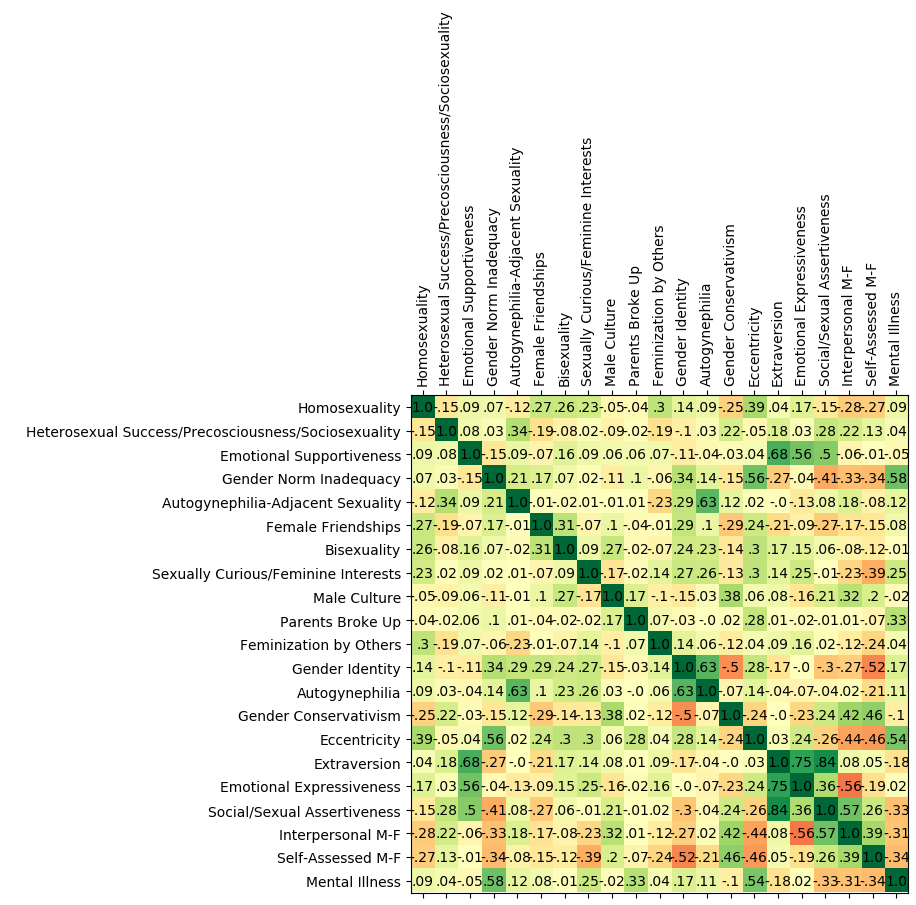
Now it might be quite tempting to say that there are quite a few variables here that correlate with Gender identity, but they might be confounded by Autogynephilia and Gender conservativism. If we residualize for those, the correlations with Gender identity weaken:
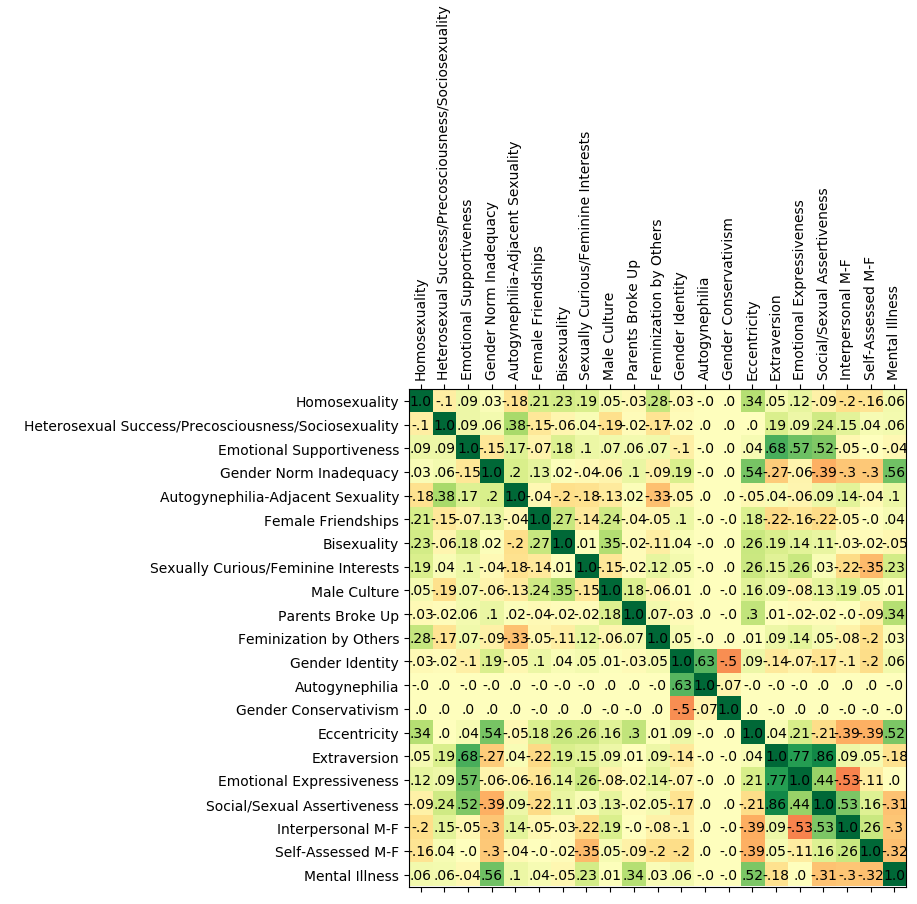
What's left is mainly stuff like "Gender Norm Inadequacy", "Social/Sexual Assertiveness", "Self-Assessed M-F". These were somewhat correlated with Gender Conservativism to begin with, and it suggests to me that maybe "Gender Conservativism" gets the idea slightly wrong, and a variable that better captures the "Macho" element while retaining much of the concept of Gender Conservativism would be better.
Now, extracting a bunch of factors is great for interpretability, but usually most of the predictive power is in the first few principal components, and that is also the case here. So it might be nice to check the predictive power for the various sources of information, separated by principal component.
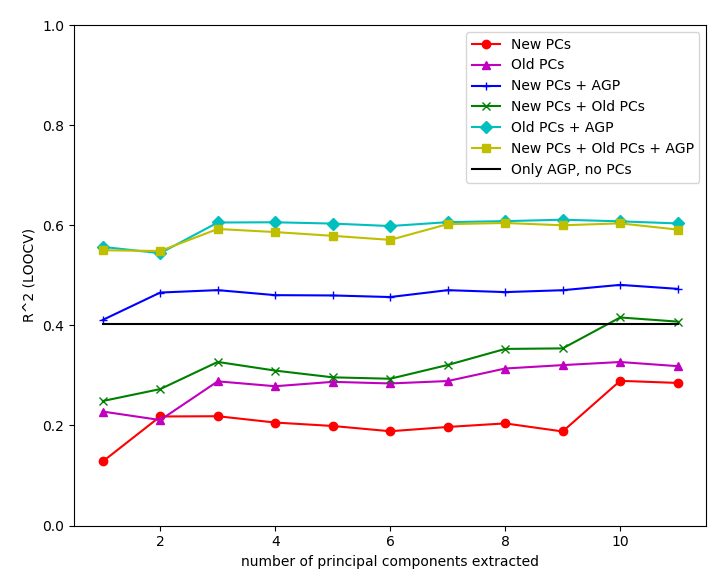
In the above plot, each node represents a model, and each curve represents a family of models that share the same dataset but which extract different numbers of principal components. More specifically, for the each of the datasets in each of the models, I extract some number of principal components, and then use linear regression to predict Gender identity. In cases where I include Autogynephilia, I add Autogynephilia together with the principal components to the linear regression. To prevent overfitting, I use leave-one-out crossvalidation.
Overall, this new survey doesn't seem to have added much predictive power beyond the original + AGP. Of course, this doesn't automatically answer the causal question - you could imagine that this survey assesses factors that are causally upstream of Gender identity, while the Autogynephilia and Gender Conservativism measures assess things that are causally downstream of Gender Identity.
Wrapping Up
There's a bunch more tiny details I looked into in this research. However, they are tiny and disconnected from everything else and they didn't amount to much, and I've already written so much, so explaining them would probably delay the results post to an unacceptable degree.
In total, I can account for maybe 60% of the variance. That's not too shabby, but it raises questions about where the remaining variance is. A lot of it might be down to measurement error - social science measures are notoriously inaccurate, and I haven't done much to increase measurement quality beyond asking an enormous number of questions. (Though at the same time, that could also lead to upwards biases.) One could also imagine that there's a substantial amount of variation that is down to non-psychological causes, or that a substantial amount of variation is just inherently interpretable.
I think the most important open question is the direction of causality. Most of the investigations into autogynephilia are fairly irrelevant if it turns out that autogynephilia is just an epiphenomenon of gender identity. I think pinning down the unexplained variance would be a big help in settling the causality. I find identifying Gender conservativism/Machismo as a big factor helpful, as it helps make sense of a lot of otherwise disconnected ideas. However, Gender conservativism doesn't actually solve this, because it already factors into most competing explanations. For instance, it is commonly proposed that Autogynephilia arises from repressing one's Gender identity. Here, Gender conservativism seems to plausibly function as the "repression" variable, and it could generate similar correlations to what I've seen here. In theory, experimental interventions might answer this question, but we don't know how to intervene on Autogynephilia or Gender identity, and interventions on Gender conservativism seem very difficult.
One thing I've been thinking about is that this is mostly a study of straight men, and so it is likely to miss factors that are particularly relevant for gay men. This is not because of any sample bias, it's just, most men are straight. However, gay men tend to be much more feminine than straight men, and the social factors that are relevant in gay men's lives have the potential to be very different, due to pairing up with men rather than with women. Furthermore, Autogynephilia, which was the central factor in straight male gender identity, seems to be rarer in gay men than straight men. As such, it might be interesting to apply these same methods to gay men. I completely blew my research budget for quite a few months on this study, but I am likely to get a grant to study gay men, which might help unveil some things.
It would also be helpful to do this sort of study on other demographics too. For instance, I would argue that Autoandrophilia is a major factor in female affective gender identity, but I also think masculinity is a bigger factor, to an extent that it isn't among males. However, I am unlikely to get around to studying that question, since I'm probably going to wrap up all my gender research as soon as possible.
Though that raises the question - why rely on me, a random blogger who does it in my spare time, rather than e.g. professional researchers in the area? I think the answer appears if we consider who researches it.
On one side of the debate, you've got people who've already drawn the bottom line that gender identity is solely due to brain masculinization/femininization, based on very dubious evidence. These people are doing ever bigger brain and gene studies to "prove" it, rather than checking broader areas of the world.
On the other side of the debate, you've got people like Michael Bailey. I can't understand exactly what is going on with Michael Bailey - he often does very bad theory/arguments, misleading statistics, avoids publishing data that challenges his views, and similar. Even when pointing it out, or proving that he is wrong, he doesn't change his ways or get interested in clarifying further, so it doesn't appear to be merely mistakes; instead it appears to be intentional fraud. In theory, borderline scientific fraud should get him totally #cancelled, but in practice he's already somewhat #cancelled due to advocating for autogynephilia theory (even though as far as I can tell on its most basic points that theory looks reasonable, as you've seen me argue in this post), and academics don't seem to do a good job of catching and removing bad research in general.
Maybe new researchers like Kevin Hsu will clean things up; we'll have to see. But until then, I'm pessimistic that society will ever get the final answers.
Thank you to Justis Mills for proofreading and feedback.
- ^
In retrospect, removing transfeminine respondents like this was probably a mistake, as it exposes me to things like collider bias. When I began this survey, I had a slightly different set of goals with it, so it made more sense back then. Specifically, removing trans people has the advantage that it may remove factors that appear as a side-effect of transitioning or reconceptualizing oneself as a woman. It probably doesn't make much of a difference, though, as trans individuals are rare.
- ^
Why did autogynephilia correlate so little by now, when I said it correlated much more strongly before? I think it's because of the primitive way I was measuring affective gender identity in these surveys; by then I hadn't yet asked the 60 extra detailed questions. However, this does suggest that the slight multidimensionality in affective gender identity does matter for what results you get. Ideally, we would do a large longitudinal study to figure out what aspects of affective gender identity best tagged the factors relevant for transition - though then I suspect the biggest missing element is that current gender transition technology is far from perfect, and therefore what matters is not just whether one wants to be a woman, but also whether one feels that current methods help enough with that.
- ^
I also investigated other things, e.g. I tried administering a personality test I had designed, and I asked some questions about how appealing it would be to have various different kinds of bodies, but these were not so interesting without further context.
- ^
The correlations are however not so high, which is not so good. This reflects the fact that I need to improve my masculinity/femininity test.
- ^
This lack of specificity is not necessarily inherent to my measure, as it arguably more generally reflects a tendency of depression and anxiety to not be very strongly distinguished; in psychopathology research they are often lumped under a common label of being "internalizing disorders".
- ^
For the General Autogynephilia Scale, I accidentally forgot three items; legs for anatomic autogynephilia, and voice and sitting position for behavioral autogynephilia. So these scales were somewhat incomplete.
- ^
I don't think parsimony tends to work in these sorts of situations, because humans are complex, but again this is just a hypothetical.